How many people did the Hobbits have? What are the demographic statistics of the fantasy world?

In the fictional city of ``
How Many Hobbits? A Demographic Analysis of Middle Earth | by Lyman Stone | Dec, 2023 | Medium
https://medium.com/@lymanstone/how-many-hobbits-a-demographic-analysis-of-middle-earth-cd53b91d141f
How Many Hobbits? Middle Earth Population by People Group | by Lyman Stone | Dec, 2023 | Medium
https://medium.com/@lymanstone/how-many-hobbits-middle-earth-population-by-people-group-60c5c9d0c5b1
Tolkien rarely reveals the population in his stories. Even if villages were drawn, the scale was hardly shown, and the big cities of Middle-earth were only shown in some areas, but not the whole picture. Nevertheless, die-hard Tolkien fans try to compile numbers such as city size and population as much as possible. Mr. Stephen Wigmore, known as one of the famous ones, has posted on his blog about the history and population estimates of elves in Middle-earth, as well as considering the land and population that appear in ``The Hobbit''.
Mr. Stone points out that many of the considerations by Tolkien fans, especially Mr. Wigmore, estimate the population from the 'size of the army.' The military is one of the few elements that Tolkien provides as a clear number, and even in the real world, calculations are sometimes made to estimate the population from the number of troops. Based on this, Mr. Stone calculates estimates for the population of Middle-earth and Hobbits by taking a 'geographical approach' in addition to military estimates. Although Tolkien's stories are divided into periods from the ``First Age'' to the ``Fourth Age,'' Mr. Stone mainly focuses on ``The Hobbit'' and ``The Lord of the Rings.'' It refers to the population of the 'Tertiary Age .'

As a geographical approach, Stone first describes Middle-earth as 'a region where human society could survive normally, and was governed by demographic and agricultural rules similar to European society around 1200 AD.' I'm assuming. They first divided Middle-earth into recognizable regions, and classified each region according to characteristics related to population, such as climate, geography, and access to water. Densities derived from modern academic estimates of medieval population densities are then used to assign population densities to each region based on its combination of topography.
As a result of estimating population density, Mr. Stone shows the following graph. In this model, there are approximately 71 people per square mile (approximately 2.6 square kilometers) in the city of Rossarnach. Although this is higher than actual medieval countries, Rotharnach is a small country located around a city, resulting in a high population density.
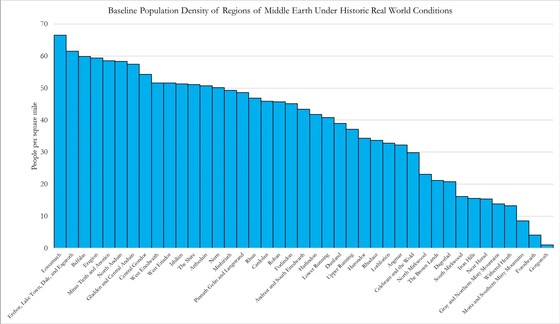
A similar population density distribution is shown below as a heat map on the map. The darker the color, the more densely populated the area is.
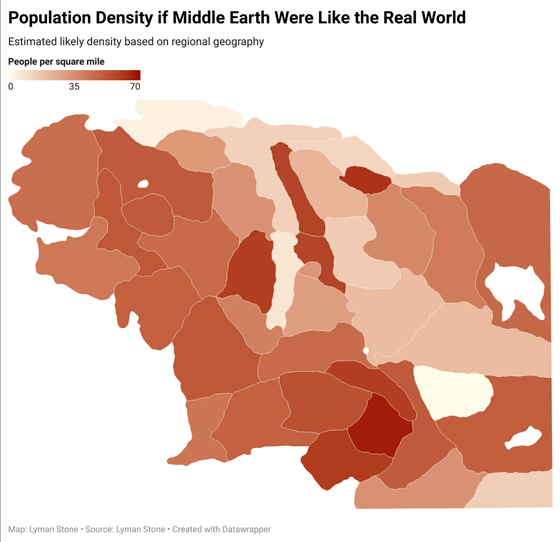
When Stone calculated the population of Middle-earth as a whole based on this population density, he came up with an estimate of ``about 26 million people.'' This is based on the assumption that ``if Middle-earth had gathered a population in a pattern similar to medieval Europe in terms of survival resources,'' it is similar to the ``3 million people'' estimated by other Tolkien fans in the past. This is an estimate that is considerably higher than that number.
Next, we need to consider the racial distribution of Middle-earth. In Middle-earth, elves, dwarves, hobbits, and orcs exist as races that form societies and live in the same way as humans. Elves in Tolkien's works are immortal, require little food, have low fertility, and prefer a sparsely populated life. Also, although hobbits are small, they have large appetites, so they should require the same amount of land as humans. However, because hobbits live primarily underground, the amount of land available is more than just square footage. Although not much is known about the ecology of dwarves, they are thought to have a fairly localized distribution, so this does not have a major impact on Stone's estimates.
Mr. Stone also mentions ``army size,'' which is often used to estimate population size. Tolkien rarely reveals the size of his land or population in his stories, but only in terms of the size of his army: ``Just under 5,000 full-time professional soldiers and guards,'' and ``another 5,000 with additional recruitment.'' There is a description of 'Soldier of.' In addition, at
From these military figures, Mr. Wigmore showed the calculation formula: ``Number of knights x 8 + number of infantry x 4 = male population in prime age.'' From this, assuming that men in their prime age account for about one-third of the population, the size of the army means that there are 16 civilians for every soldier, and that the population of Rohan , the kingdom of Middle-earth, is approximately 600,000. You can derive it. Regarding this calculation formula, Mr. Stone examines the major wars of the Middle Ages and compares the size of the army and the population to verify the correctness of the ratio between the army and the population.
The table below shows the results verified from actual wars. Regarding the 'population per soldier' on the far right of the table, the average is '60 to 120', and based on this, the figure of '16 civilians per soldier' calculated by Mr. Wigmore is ' 'It's within the plausible range, but it's too low,' Stone noted. However, Stone only looked at a small number of famous wars and did not take extreme cases into account.
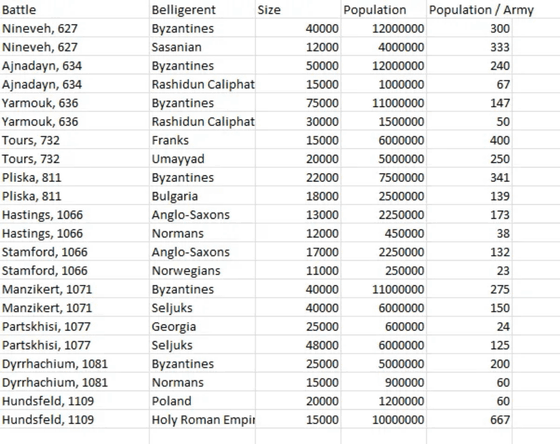
Using similar calculations, Mr. Stone has derived that the population of the kingdom of Gondor is about 1 million people, and that there are 52,000 elves living in the elf area. Overall, Stone assumes a much larger population than Wigmore and other previous estimates.
One of the important factors that cannot be explained by Mr. Stone's geographical approach is the ``historical circumstances of the land''. Tolkien's works often feature 'population pressures' such as giant spiders, evil orcs, trolls, plagues, and bandits. Therefore, Mr. Stone added a ``population decline variable'' to the geographical estimates, and although it was somewhat arbitrary, he applied a population decline rate that picked up as much as possible from the depiction in the work. As a result, the population density heat map of Middle-earth changes as shown in the image below, and the estimated value has decreased from the initial estimate of ``about 26 million people'' to ``about 7.6 million people.''
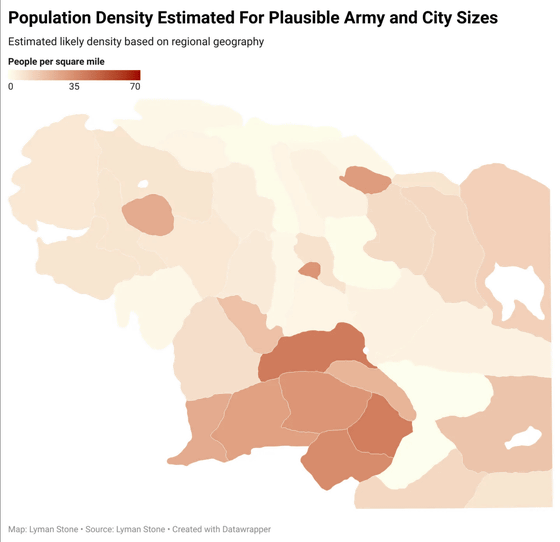
After concluding that the total population of humans, elves, dwarves, and hobbits living in Middle-earth was approximately 7.6 million, Mr. Stone further analyzed the population of each type, ``How many hobbits were there?'' ?” answers the question. The hobbit populations shown by Mr. Stone on the map of Middle-earth are as follows. Most hobbits are concentrated in the Shire, an area also known as the Hobbit Village, with Stone giving an estimate of about 180,000 people. The remaining 20,000 hobbits are scattered throughout the country, and it is thought that there were less than 200,000 hobbits in all of Middle-earth.
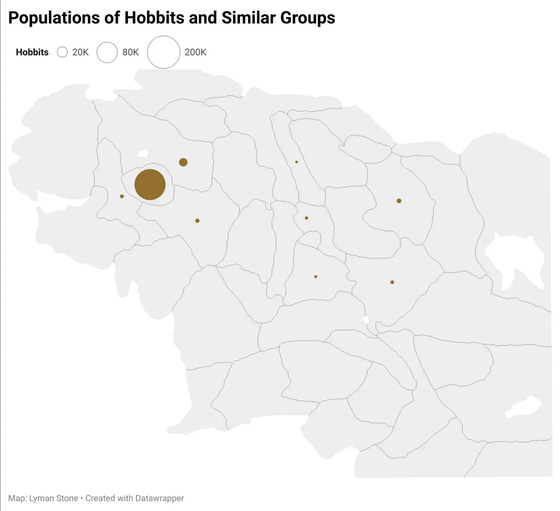
As for elves, Stone estimates there are about 296,000 elves across the northwest region of Middle-earth. Wigmore and other commentators estimate that 'there were about 2 million elves in
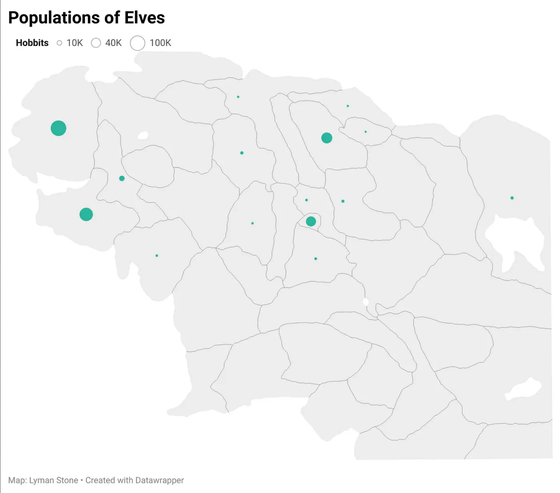
Dwarves are the smallest group, with a total number of about 110,000, half of whom live in the underground city of the dwarf kingdom '
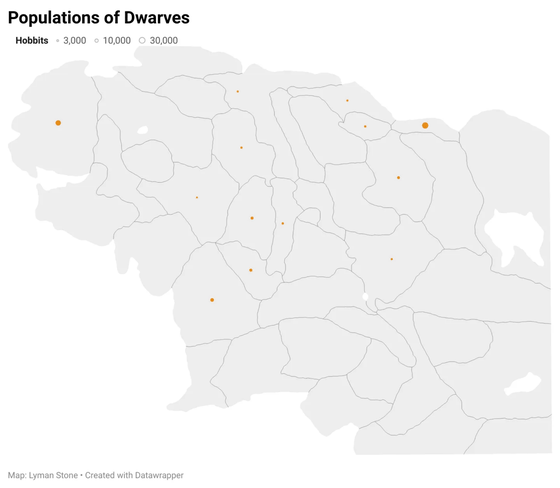
Humans are by far the largest population at around 7 million people, and large groups exist almost evenly across the northwestern part of Middle-earth. Mr. Stone calculates the human population as the remaining number after subtracting hobbits, elves, and dwarves from the total population.
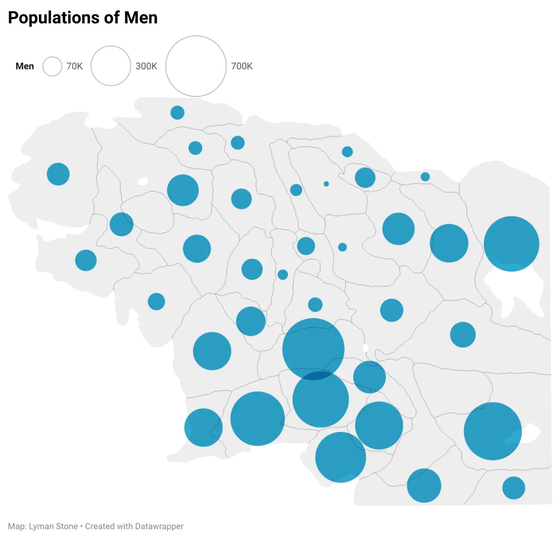
In addition to humans, hobbits, elves, and dwarves, intelligent races such as orcs and goblins also exist in Middle-earth. There are not as many clear hints about the number of orcs and goblins in the story as there are other races, but from depictions of armies in various wars, it can be estimated that there are between 500,000 and 1.5 million orcs and goblins in total. Ultimately, Stone concludes that the 'intelligent population' of Third Age Middle-earth was '9.5 to 11 million people.'
Related Posts:
in Note, Posted by log1e_dh







